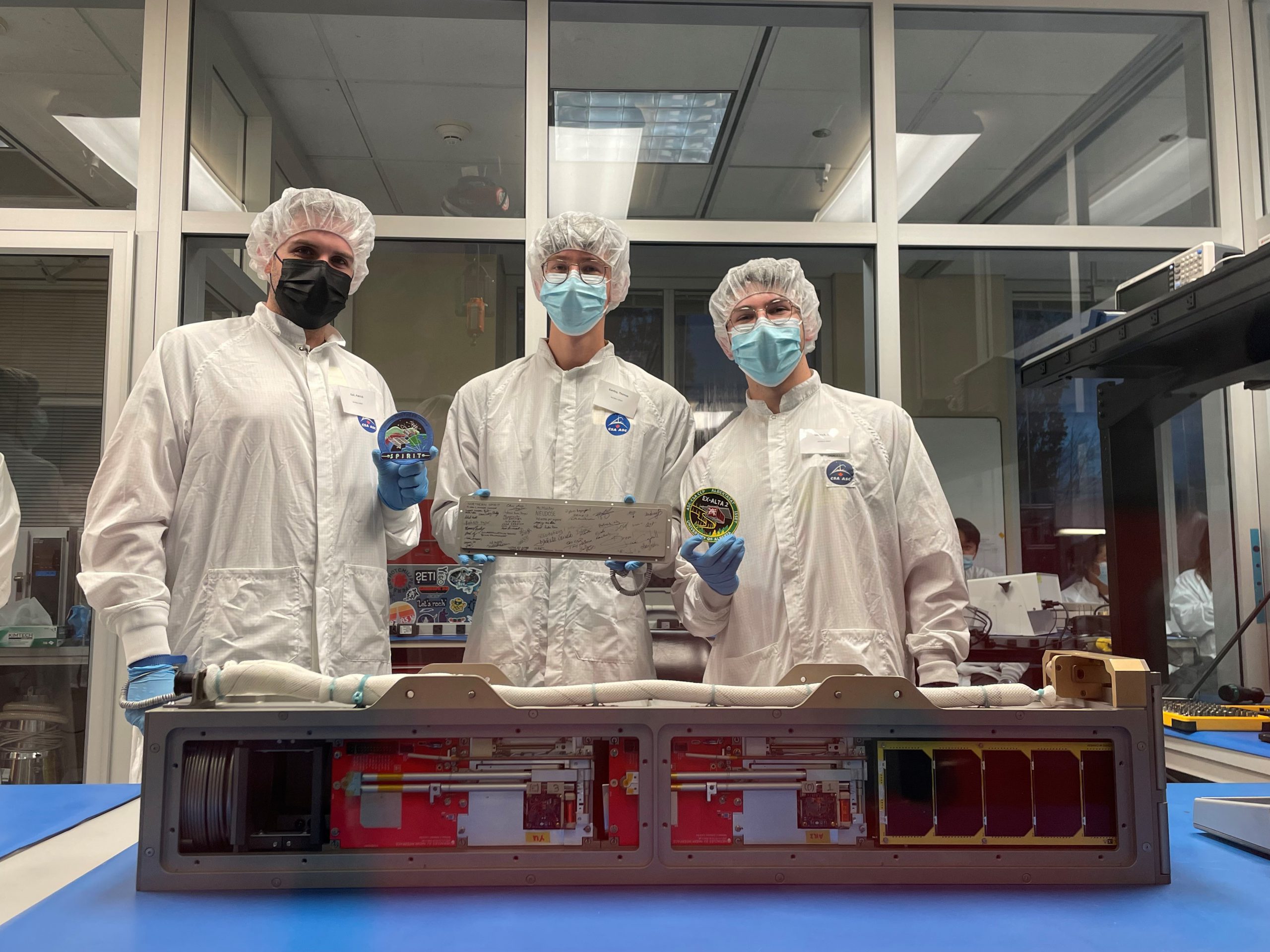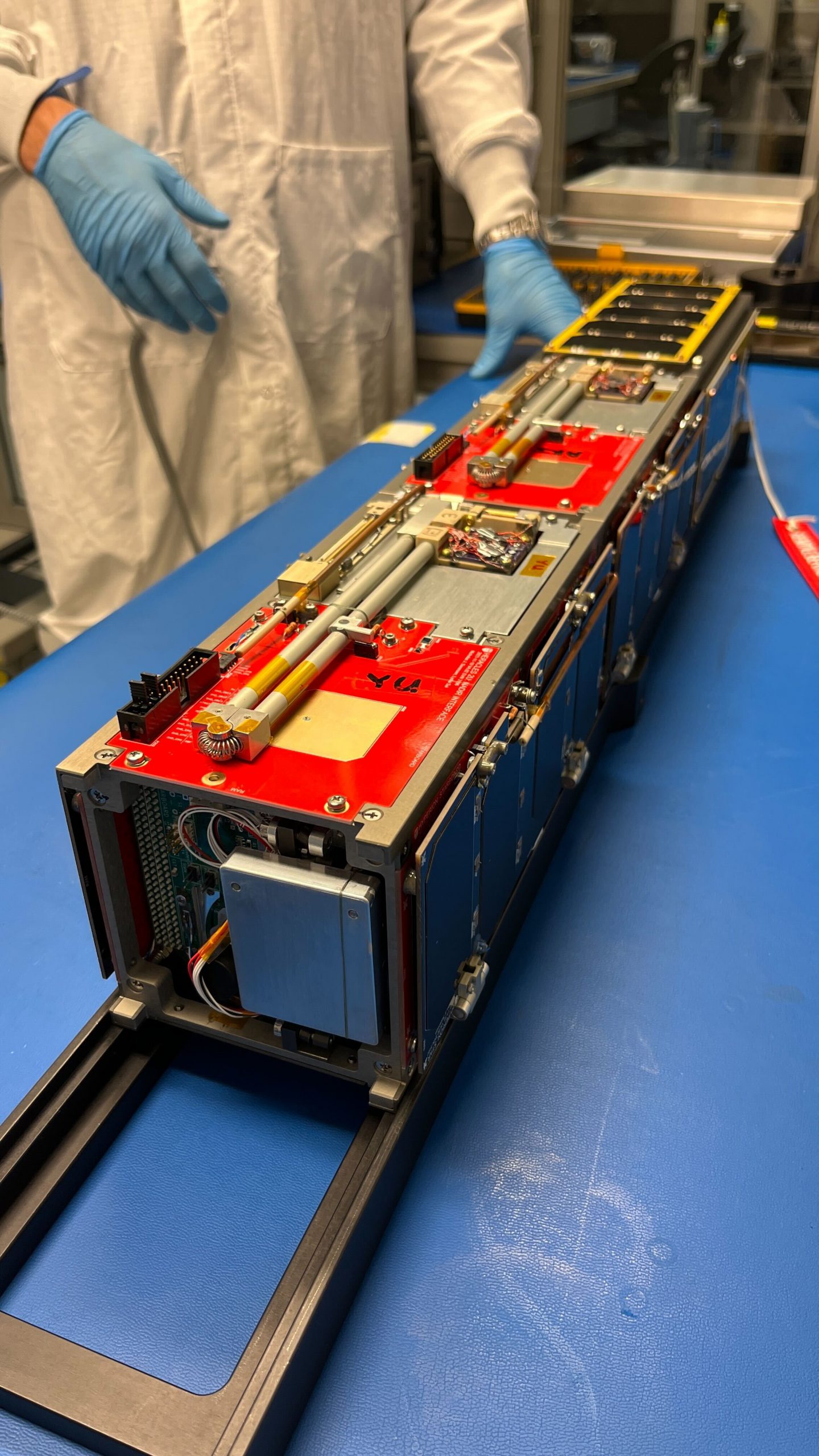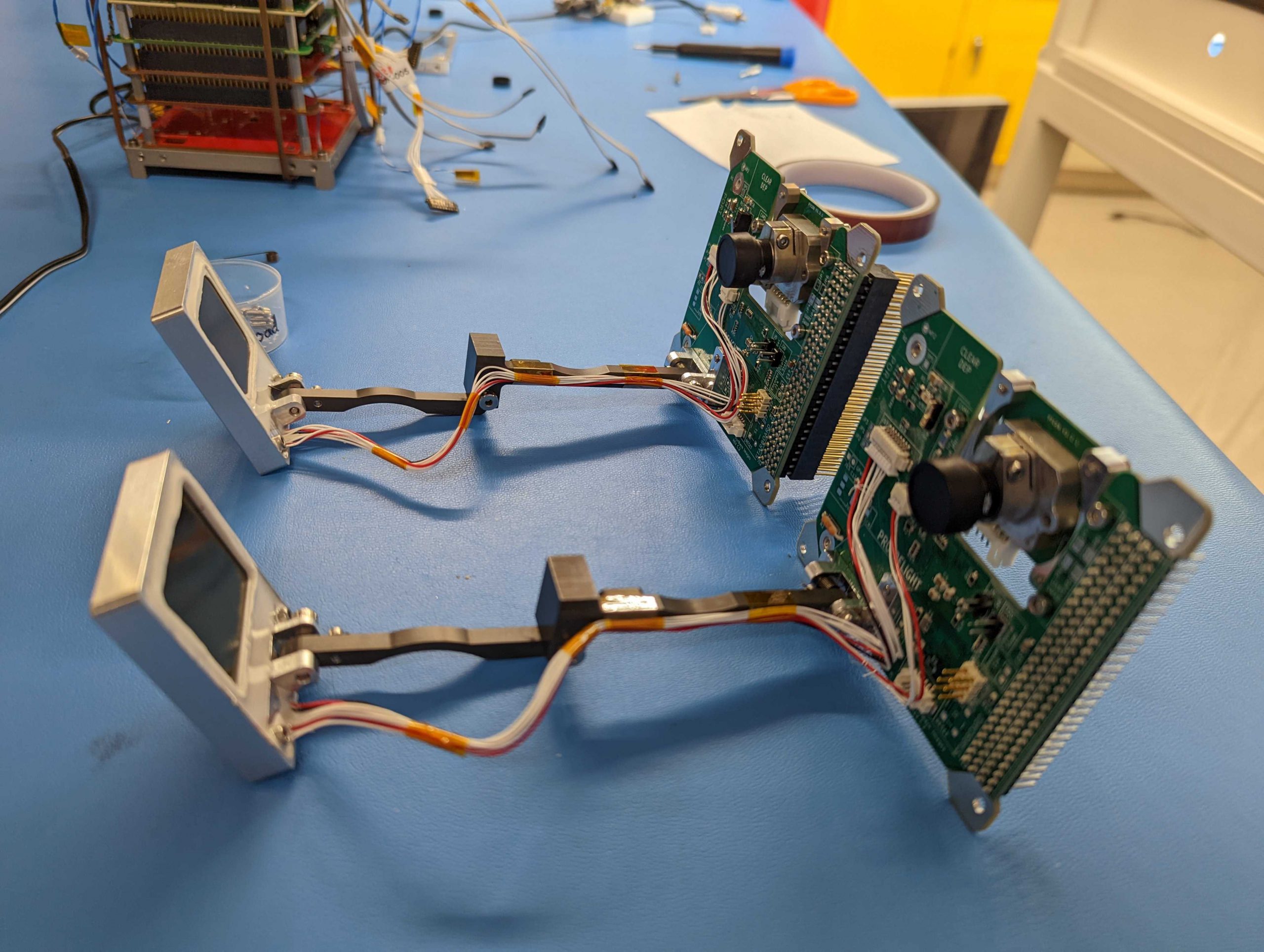La version française suit le texte anglais.
INUVIK, NT – At 6:30 PM Mountain Time on March 14, Aurora College’s AuroraSat nanosatellite was launched from Cape Canaveral, Florida, to the International Space Station (ISS) via a SpaceX-27 Falcon 9 rocket and Cargo Dragon spacecraft. Upon arrival at the ISS, astronauts will launch AuroraSat into an orbit around the earth.
Although it won’t pass over Inuvik, staff there will still be able to communicate with the satellite for four five-minute blocks per day. The satellite is expected to remain in orbit for approximately one year.
High school students from the Inuvik Robotics Club helped Aurora Research Institute (ARI) staff to design and build the satellite. Nine students were involved during the live of the project, including a computer science student on a six-month internship.
Since 2018, Aurora College has participated in the Canadian CubeSat Project (CCP) by constructing AuroraSat in collaboration with Yukon University and the University of Alberta. This partnership unites the three institutions and their individual CubeSats under the name Northern SPIRIT (Space Program with Interesting Research and Integrated Training). https://en.wikipedia.org/wiki/SpaceX_CRS-27
As part of the CCP, 15 student teams from post-secondary institutions in each province and territory designed and built their own CubeSats, with guidance from Canadian Space Agency experts and representatives from the Canadian space industry. A CubeSat is a miniaturized satellite that is a 10 cm x 10 cm cube, weighing less than two kilograms and typically using off-the-shelf electronic components. AuroraSat is a two-unit (2U – 10 cm x 10 cm x 22.70 cm) CubeSat.
Final preparations, including testing to ensure the CubeSats could withstand the temperatures in space, transmit data to the surface, and meet international safety protocols, were completed in late November 2022 to qualify the CubeSats to be launched into space and deployed from the ISS.
Aurora College has developed three outreach missions for AuroraSat called Northern Images, Northern Voices, and Northern Games, which aim to provide STEM outreach opportunities to youth and interested participants in the NWT at the elementary and high school levels. Alongside these outreach missions, AuroraSat will also fly a shared scientific mission, which will be conducted on the satellites built by Yukon University and the University of Alberta. Running the same experiment on all three satellites enables the gathering of spatially distributed data. More information about the shared scientific mission is available on the AlbertaSat website.
Northern Images Mission:
- The Northern Images Mission will display artwork submitted by NWT youth in front of a camera mounted on the CubeSat and photographed with the earth’s horizon in the background. NWT artists can continue to submit their artwork, as images can be uploaded and downloaded while AuroraSat orbits the Earth. For more information or to submit artwork, visit https://northernimagesmission.ca or contact cubesat@nwtresearch.com .
Northern Voices Mission:
- The Northern Voices Mission will feature recordings of northern stories about space and sky and transmit them to amateur radios across the country in various languages on a rotating schedule. The Aurora College team is currently working on the details of how to contribute recordings and the requirements needed to receive them from the satellite.
Northern Games Mission:
- The Northern Games Mission invites participants to create an interactive game for amateur radio operators around the world. Specific data packets will be transmitted in certain geographic zones, requiring global cooperation to decode the complete message. The game’s content will revolve around northern Indigenous histories and languages. The details regarding the specific frequencies and data structures that will be used in the Northern Games Mission are still under development.
Quotes:
“After many years of Northern students being involved in the design and construction of AuroraSat, through the space mission partnership (Northern SPIRIT), it is very exciting to have the payload launched from the International Space Station this month. The exposure to science, technology, engineering and mathematics (STEM) for all Northerners during the satellite build and flying virtually as part of the AuroraSat mission, will spark the next generation of Northern space explorers.”
– Joel McAlister, Vice President Research, Aurora College
“The Northern SPIRIT consortium has provided a unique opportunity to show that technical work, such as the construction of a satellite payload, can be done in the North. As we continue to transform into a polytechnic university, we hope that our participation in programs such as this provides the opportunities and awareness for the benefits of a technical post-secondary education and employment opportunities that are possible inside the NWT. “
– Patrick Gall, Engineering & Technology Projects Technician, Aurora College
AuroraSat, le nanosatellite construit aux TNO, a été lancé dans l’espace
Inuvik, TNO – À 18 h 30, heure des Rocheuses, le 14 mars, le nanosatellite du Collège Aurora, AuroraSat, a été lancé dans l’espace depuis Cap Canaveral, en Floride. Il atteindra la Station spatiale internationale (SSI) à bord de la capsule Dragon, laquelle est transportée par une fusée Falcon 9 SpaceX-27. Une fois arrivé à la station spatiale, le nanosatellite sera mis en orbite par les astronautes.
Bien que ce dernier ne passe pas au-dessus d’Inuvik, le personnel du Collège sera en mesure de communiquer avec lui quatre fois par jour, cinq minutes à chaque fois. Le nanosatellite devrait rester en orbite environ un an.
Les élèves du secondaire du club de robotique d’Inuvik ont aidé le personnel de l’Institut de recherche Aurora (IRA) à concevoir et à construire le satellite. Neuf étudiants ont contribué à la réalisation du projet, notamment un étudiant en informatique qui a travaillé sur le satellite pendant six mois dans le cadre d’un stage.
Le Collège Aurora participe à l’Initiative canadienne CubeSats depuis 2018 et travaille depuis lors à la création d’AuroraSat en collaboration avec l’Université du Yukon et l’Université de l’Alberta. Un partenariat réunit ces trois établissements postsecondaires et leurs CubeSats sous le nom de Northern SPIRIT, le Programme spatial de recherche intéressante et de formation intégrée (en anglais, le « Space Program with Interesting Research and Integrated Training »). https://en.wikipedia.org/wiki/SpaceX_CRS-27
Dans le cadre de l’Initiative canadienne CubeSats, quinze équipes, composées d’étudiants d’établissements postsecondaires de tout le pays, ont conçu et construit leur propre CubeSat, avec l’aide d’experts de l’Agence spatiale canadienne et de représentants de l’industrie spatiale canadienne. Les CubeSats sont des satellites cubiques miniatures de 10 cm x 10 cm x 10 cm et de moins de deux kilogrammes qui sont généralement construits à l’aide de composants électroniques disponibles sur le marché. AuroraSat, pour sa part, est un CubeSat composé de deux unités (2U – 10 cm x 10 cm x 22,70 cm).
Les derniers préparatifs ont été achevés fin novembre 2022. Ils comprenaient notamment des tests visant à vérifier que les CubeSats sont capables de résister aux températures de l’espace et de transmettre des données à la Terre, mais aussi qu’ils respectent les protocoles de sécurité internationaux. Leur lancement dans l’espace et leur déploiement à partir de la SSI a ainsi pu être approuvé.
Les élèves du Collège Aurora ont attribué trois missions éducatives au nanosatellite AuroraSat. Intitulées « Northern Images », « Northern Voices » et « Northern Games », elles visent à promouvoir les STIM (sciences, technologies, ingénierie et mathématiques) auprès des jeunes ténois, tant à l’école primaire qu’à l’école secondaire. En parallèle de ces missions éducatives, AuroraSat poursuit également un objectif scientifique, qui sera partagé par l’Université du Yukon et l’Université de l’Alberta : il s’agit d’exécuter la même expérience sur les trois satellites, de sorte à recueillir des données spatiales plus importantes. De plus amples renseignements sur cette mission commune sont disponibles sur le site Web d’AlbertaSat.
Mission « Northern Images » :
- La mission Northern Images vise à exposer des œuvres d’art de jeunes artistes ténois dans l’espace. Celles-ci seront prises en photo par une caméra, montée sur le CubeSat, et la Terre sera visible en arrière-plan. Les artistes des TNO peuvent continuer à soumettre leurs œuvres d’art, car les images peuvent être téléversées vers le satellite, même s’il est déjà en orbite autour de la Terre. Pour plus d’informations ou pour soumettre des œuvres d’art, visitez le northernimagesmission.ca ou contactez cubesat@nwtresearch.com.
Mission « Northern Voices » :
- La mission Northern Voices vise à transmettre des enregistrements d’histoires nordiques sur l’espace et le ciel à des radioamateurs de tout le pays, et ce, dans différentes langues et selon un horaire tournant. L’équipe du Collège Aurora travaille actuellement sur les modalités de contribution des enregistrements et sur les conditions à réunir pour que le satellite soit en mesure de les recevoir.
Mission « Northern Games » :
- La mission Northern Games permet aux participants de créer un jeu interactif pour les radioamateurs du monde entier. Ces derniers devront décoder un message à l’aide de paquets de données spécifiques transmis dans certaines zones géographiques; il leur faudra ainsi collaborer avec le reste du monde pour obtenir l’entièreté du message. Le contenu du jeu s’articulera autour de l’histoire et des langues autochtones du Nord. L’équipe travaille actuellement sur les fréquences et sur les structures de données qui seront utilisées dans le cadre de cette mission.
Citations :
« Après de nombreuses années passées sur la conception et la construction du nanosatellite AuroraSat, les étudiants ténois vont enfin pouvoir voir l’aboutissement du projet Northern SPIRIT. Nous sommes très excités à l’idée de bientôt observer le lancement en orbite du nanosatellite depuis la Station spatiale internationale. La construction de ce dernier et son temps dans l’espace nous permettent de promouvoir les sciences, la technologie, l’ingénierie et les mathématiques (STIM) auprès de tous les résidents des TNO, ce qui donnera, je l’espère, naissance à une génération d’explorateurs de l’espace ténois. »
– Joel McAlister, vice-président à la recherche du Collège Aurora
« Le consortium Northern SPIRIT a été l’occasion parfaite de prouver qu’un travail technique, tel que la construction d’une charge utile de satellite, peut être effectué dans le Nord. Alors que nous poursuivons notre transformation en université polytechnique, nous espérons que notre participation à des initiatives comme celle-ci nous permettra de faire connaître les avantages d’un enseignement postsecondaire technique et les possibilités d’emploi qui existent aux TNO. »
– Patrick Gall, technicien de projets d’ingénierie et de technologie du Collège Aurora

Patrick Gall, Engineering and Technology Projects Technician, Aurora Research Institute, with fellow Group D members Thomas Ganley and Josh Lazaruk with their CubeSats – AuroraSat, YukonSat and NEODOSE (McMaster University) – which have been integrated into the deployer. (Photo Courtesy of Patrick Gall)
Patrick Gall, technicien de projets d’ingénierie et de technologie à l’Institut de recherche Aurora, et ses collègues du groupe D, Thomas Ganley et Josh Lazaruk, avec leurs CubeSats : AuroraSat, YukonSat et NEODOSE (Université McMaster), lesquels ont été intégrés au dispositif de déploiement. (Photo : Patrick Gall)

YukonSat, AuroraSat and NEODOSE sitting on the integration jig. The Northern Images mission payload sitting on the end of YukonSat, nearest the camera. (Credit Joanne Cai, University of Alberta)
YukonSat, AuroraSat et NEODOSE sur le dispositif d’intégration. La charge utile de la mission Northern Images est placée à l’extrémité de YukonSat, le plus proche possible de la caméra. (Photo : Joanne Cai, Université de l’Alberta)

Two copies of the Northern Images Mission, designed and assembled in the NT, ready for assembly into the rest of the satellite. One copy ended up on AuroraSat, and the second on YukonSat.
Deux exemplaires des dispositifs nécessaires à la mission Northern Images, conçus et assemblés aux TNO, prêts à être assemblés au reste du satellite. Un exemplaire a été installé sur AuroraSat et le second sur YukonSat.
